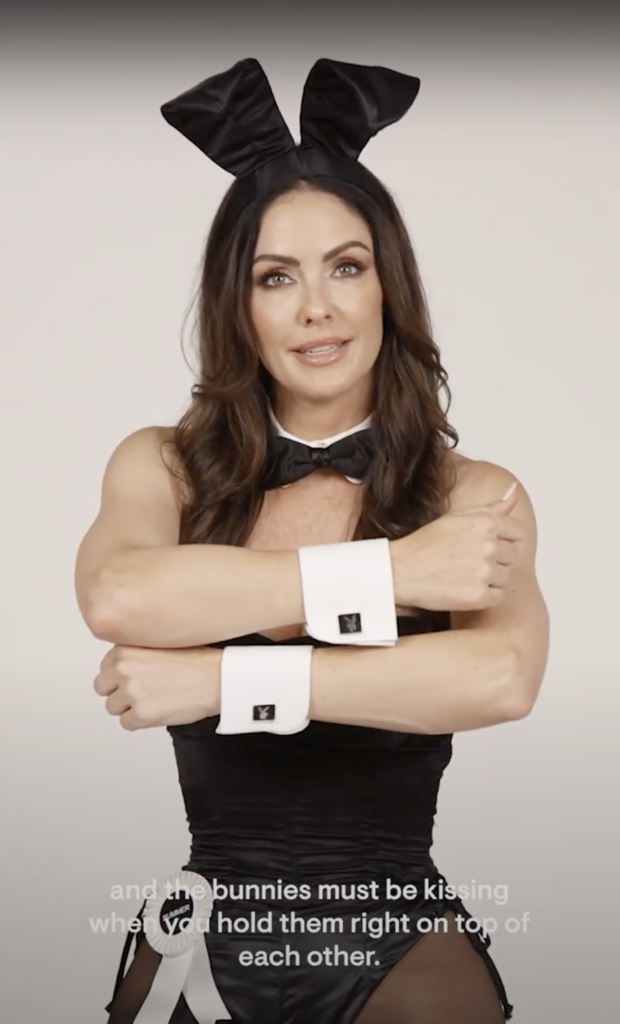As Halloween approaches and you’re thinking about the costume you want to wear to the big party, it’s likely that going as a Playboy Bunny may have crossed your mind if you’re trying to go for a sexy vibe. But, the legendary Bunny suit is way more than just a costume. It’s a symbol of female empowerment.
The design of the suit has evolved over the decades for the iconic women who have worn it. Women have always played a pivotal role in the suit’s creation, including Ilse Taurins, who worked with her seamstress mother to develop the one-piece design of the bodice. Black American designer Zelda Wynn Valdes also crafted early versions for the Playboy Club in 1962.
Today, versions of the Bunny suit are featured in prestigious art institutions. One has previously been featured in The Costume Institute at The Metropolitan Museum of Art in New York and at the Smithsonian National Museum of American History in Washington D.C.
Here are five facts about the Playboy Bunny suit that you may not know.
1. The Bunny suit became the first service uniform registered with the United States Patent and Trademark Office (USPTO)
First introduced in 1960 with the opening of the first Playboy Club, the Bunny suit became the first service uniform registered with the USPTO.
“The signature Bunny costume, with its fluffy tail, white collar, cuffs, black bow tie and perky ears, can lay claim to the only patent ever granted a service uniform by the United States Patent Office (patent #762,883),” writes Kathryn Leigh Scott in the book The Bunny Years.
2. The bunnies on the official cufflinks must be kissing
The suit includes cuffs with official Playboy Bunny cufflinks. “The bunnies must be kissing when you hold them right on top of each other so you can see the Bunny properly when your hands are on your hips,” says Miss August 2000 Playmate and Playboy Bunny Summer Altice.

3. The heel on the pointed-toe pump must be a minimum of three inches
Shoes, which were also the responsibility of the Bunny to purchase and maintain, had to have a minimum three-inch heel, according to History Collection. “Due to the requirement of constantly wearing three-inch or taller heels, the Bunny Manual also had tips on dealing with the pain of being in such high shoes. One recommendation was to roll the feet back and forth over a Coke bottle to ease sore arches.”
4. The first iterations of the Bunny suit uniform for The Playboy Club came with only two bust sizes: 34D and 36D
Bra stuffing was sometimes a necessity for early Playboy Bunnies. “If you aren’t familiar with bust sizes, those two sizes describe women with small rib cages and large breasts. Many women aren’t born with that large of a bust, especially with a very small frame,” according to History Collection. “So, Bunnies would use different items to fill out the cups of their uniforms. Some items they used were socks, Kleenex, or crumpled dry cleaning bags.”
“In 1964, a washable and highly durable one-piece boned foundation [of the corset] was adopted in a variety of colors, but only two cup sizes, a wishful 34D and 36D—requiring considerable padding for most Bunnies,” wrote Scott.
Fun fact: The Bunnies also used their extra bra cup space to stash their tips, which led to their bras being known as “the vault.”
5. The original Bunny suit came in 12 different color shades
The Bunny costume was initially available in 12 different shades. But the most popular colors were red, peacock blue, and emerald green, according to Scott.
Related: Actress Nicola Peltz Stuns in Playboy Bunny Instagram Shoot
There were specialized Bunny suits as well. “When the VIP Room, serving ‘Very Important Playboys,’ a prix fixe three-course dinner was inaugurated with the opening of the New York Club, an elegant blue velvet costume with silver trim was introduced for mostly foreign-born Bunnies who worked the plush room,” writes Scott. “In the late 1960s, Emilio Pucci-influenced prints were introduced. Polka dots and psychedelic prints followed in the disco era. In July 1980, the lace-and-satin Bunny Cabaret costume was introduced, featuring mesh stockings, garters, and dyed pumps.”
As the Bunny suit evolved, there have been many iterations of the costume over the years that were reimagined by famous designers. “The Blonds did their own redesign for their fashion show and Roberto Cavalli did a redesign for the Palms Casino. In the 1980s, there was a massive redesign of the costume for the clubs, especially in Los Angeles. There were cabaret Bunnies and there were actual costume costumes. If I remember correctly, there was a Dorothy costume, a chef costume, a bride costume, a pirate Bunny costume, and a cool bellhop costume,” says Altice.